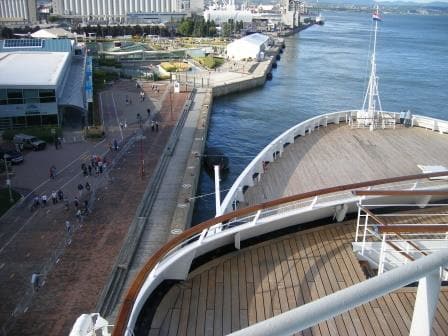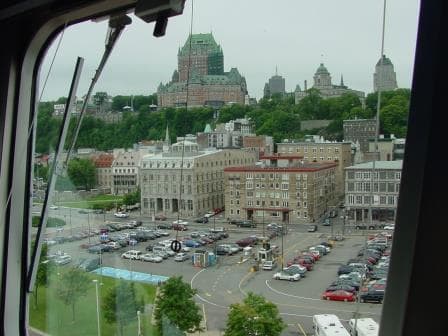07 Sept. 2014; Quebec, Canada.
The pilots did not have any issues with the bridge time, the tides followed the predicted schedule and the Maasdam slipped under the Bridge without any challenges. Then she docked shortly after. This was very shortly after as the ship went straight alongside the downtown dock.
That is not always the case as it depends from which side the current is coming. Unless there is a very special situation, a ship on the St. Lawrence River will always dock with the nose into the current. This means that when it is ebbing (the current follows the flow of the river to the sea) the ship will dock with the bow stream up wards. When it is flooding (the tide of the sea is going against the flow of the river) the ship will dock with the nose into the flood. It will dock with the bow in the direction of the sea, where the flood is coming from. Although the St. Lawrence River can flow very strongly, especially in the spring, the flow is normally weaker than the upcoming flood and thus the flood is the current to keep an eye on.
This is the normal sequence of docking. However there might be exemptions and I have been docking at times where the downward flow of the river was cancelled out by the upward flow of the tide and as a result there was no current near the docks. In the middle of the river there was a lot of turmoil with swirling currents, where the two water flows fought for supremacy but near the docks, where the current is normally a little bit less, there was nothing. Then the pilots allow the ship to dock any side alongside and thus you try to dock with the bow in the direction of where you go next.
This time the Maasdam could dock quickly as it was flooding, so the ship already had the bow pointing the right way. It was also the direction of where we would go down river later and that would ensure a speedy departure. If it had been ebbing, then the ship would have had to turn in the river and then find its way back to the dock. That would have taken almost an hour longer.
But by 3 am it was all fast and all involved could go back to bed. Daylight was around 0600 and that meant that early birds could go ashore at that time. As it is Sunday today not much happened in the early morning, which is always a perfect time to explore the old city. Quebec is a wonderful town. On the Holland America rating of ports it scores year after year the highest of all the different ports that we visit in the world and that is over 300. Most people also take the chance to visit Chateau Frontenac, which is not really a Castle but a hotel. But it certainly looks like a castle. It was built in the days when the Railways were being laid through Canada and connections were being made with the Ocean Liners. No expense was spared and only the best was good enough. It is really wonderful to walk around in the down stairs area, where the old style charm of the place has been completely retained. I really wish that I would have the opportunity to walk that Castle/Chateau/Hotel from the top of the roof to the deepest dungeon, just to see what they put in such a building in those olden days.
It was a cool day with real nippy weather in the morning but when the sun came out it was a glorious day to be ashore. As it was Sunday, half the town was on parade in front of the ship in the afternoon, as the pier doubles up as a sort of small boulevard, cum Public Park. It gave the Quebecois the chance to see a Holland America ship but also to see how the sailors were cleaning and painting the outside, as the Staff Captain had arranged for a cherry picker to be used for the duration of the call.
Tomorrow is a sea day and then the next port of call is Charlotte Town on Prince Edward Island. That is a tight run as the ship has to go the long route due to the lobster pot season but that is for the next blog when we get close to the next port of call.

The concrete dock walls of Quebec. Please note how the fender is pushed off the wall by the current that runs between the dock wall and the ship.
Departure from Quebec is normally easy; the current tries to get between the ship and the dock, either from the stern (ebbing) or from the bow (flooding).
Whatever the direction of the current, it will push you off the dock mainly due to the fact that all the Dock walls in Quebec are from concrete and solid so any water that comes against it is bounced off again. And if the ship lets go of it mooring lines, then it will bounce off as well.
The weather forecast for tomorrow will be chilly but sunny, with strong winds while the ship is sailing down the St. Lawrence Estuary and then later a gentle breeze when it enters open waters.


September 8, 2014 at 8:35 pm
The HAL rating of ports putting Quebec city at the top is surprising to me. But, that is I imagine, the rating done by the passengers on board HAL cruises? I do not know the entire city of Quebec. But, as for the “old town”, the historic city center, I’m surprised Tallinn (Estonia) has not taken over yet from all the other ports that are visited by Holland America. That ‘old town” was one BIG eye-opener for me, partly raised in the northern part of Europe.